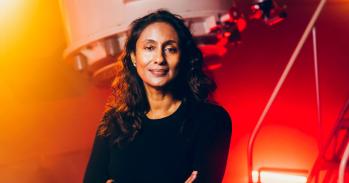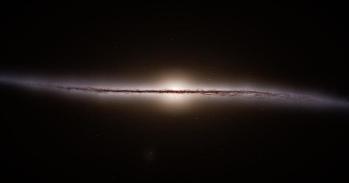
Scientists at Cambridge’s Kavli Institute are studying how the Universe developed after the Big Bang by analysing light emitted up to 13.7 billion years ago.
Scientists at Cambridge’s Kavli Institute are studying how the Universe developed after the Big Bang by analysing light emitted up to 13.7 billion years ago.
The concept of reconstructing, in three dimensions, events that happened over a time span of nearly 14 billion years is no longer just a dream.
Professor George Efstathiou
It may be one of Cambridge’s newest buildings but its historic roots lie in one of the University’s oldest scientific research departments. The £4 million Kavli Institute for Cosmology Cambridge (KICC), opened in 2009, is built just yards from the University Observatory, where astronomical research has been carried out since the early 19th century. In the intervening years, Cambridge has developed an international reputation for ground-breaking discoveries about the origin, evolution and structure of the Universe, thanks to research in the Institute of Astronomy, the Department of Physics’ Cavendish Laboratory and the Department of Applied Maths and Theoretical Physics (DAMTP).
The driving force for the new Institute was to bring together some of the groups from these departments, as Professor George Efstathiou, Director of KICC, explained: ‘The spread of research across departments owes much to the natural divisions that resulted from the diverse ‘tool boxes’ used to study different areas of cosmology, such as the events following the Big Bang, the birth of stars, the structure of the Universe and so on. Today, though, there are increasing overlaps and it makes sense to integrate research programmes where there is common ground.’
KICC is now home to 55 scientists, including many graduate students from each department, and is also recruiting a new generation of research scientists: Drs George Becker, Ian McCarthy and Carrie MacTavish are the first Kavli Institute Fellows to be appointed, funded by an endowment from The Kavli Foundation to pursue independent research in Cambridge.
‘Fossil record’ of the early Universe
Where did our Universe come from? What is it made of? How is it evolving? To help answer some of the most fundamental questions about the Universe, researchers at KICC are members of international collaborations that are making use of some the most advanced scientific instruments ever constructed – satellites such as the £1.7 billion Planck and Herschel Observatories launched by the European Space Agency last year. Such instruments will provide insight into events that happened billions of years ago – the Universe’s unique ‘fossil record’ – by analysing the light emitted in the distant past but which is only reaching us now.
‘The furthest back we can currently detect corresponds to light that was emitted 300,000 years after the Big Bang, just under 13.7 billion years ago, when the Universe was as hot as the surface of the Sun,’ explained Professor Anthony Lasenby, Deputy Director of KICC. ‘When it was emitted, it was visible light, but because the Universe has expanded by a factor of over a thousand, it has stretched out and become cosmic microwave background radiation.’ The Planck satellite will measure tiny fluctuations in the radiation with the highest accuracy ever achieved.
Working in partnership with over 40 institutes as part of the pan-European Planck collaboration, Cambridge scientists have been part of the satellite’s scientific programme since its inception in 1993, and are now involved in analysing and interpreting the vast amounts of data delivered back to Earth. The satellite will complete a full scan of the whole sky every six months until the end of 2011, providing information to test theories of the early Universe and the origin of cosmic structure.
Shifting into the red
After the Big Bang, the first stars are thought to have formed out of a network of matter that grew from the tiny fluctuations seen in the cosmic microwave background. Dr Martin Haehnelt, Dr George Becker and others at KICC are studying the composition of this network, which is known as the intergalactic medium. ‘The energy released from the first stars would have had a dramatic impact on the medium around them, changing the way future stars and galaxies would form,’ Dr Becker explained. ‘We can study the intergalactic medium from when the Universe was about a billion years old through to the present, but we’d like to go even earlier, closer to the Big Bang, because it contains the fingerprint of the initial and changing conditions needed to form what we see today.’
To do this, cosmologists are looking at the high-redshift Universe. As the Universe expands, light produced by distant stars and galaxies is stretched to longer wavelengths, changing the apparent colour of the light: the more distant the object, the redder its light becomes by the time it reaches Earth. As a result, highly redshifted objects trace the earliest phases of the Universe’s evolution. Using the University’s Darwin supercomputer, Dr Becker is analysing data showing the thermal and gaseous history of the Universe to understand the ingredients needed for galaxy formation.
Researchers at the Kavli are also studying the high-redshift Universe in order to catch first sight of young galaxies. By searching the sky at unprecedented levels of sensitivity, a team led by Dr Haehnelt has discovered very faint traces of long-searched-for galaxies.
Radio telescopes of the future
Kavli scientist Dr John Richer is the UK Project Scientist for ALMA, the Atacama Large Millimetre Array, a huge radio telescope sited in the Atacama Desert of northern Chile. ALMA is the result of collaboration between 17 countries worldwide. When completed in 2013, it will provide the first detailed images of the gaseous component of high-redshift galaxies; in addition, it will map the structure of the discs of material that surround newly formed stars in which planetary systems are known to form. To do this, ALMA will combine data from 66 radio antennas to construct a telescope with an effective diameter of 10 miles, using the technique of aperture synthesis that won Cambridge astronomers Sir Martin Ryle and Professor Antony Hewish the 1974 Nobel Prize in Physics.
Meanwhile, a Cambridge team led by Dr Paul Alexander is providing crucial input into the science, design and costing of the Square Kilometre Array (SKA) radio telescope; Dr Alexander leads the UK technical work on the SKA design, heading a team split between Cambridge, Manchester and Oxford. Construction of the first phase of the instrument is expected in 2015, with completion in 2020. Dr Alexander explained the importance of this new development: ‘The SKA will be 100 times more sensitive than the radio telescopes of the present generation, and will be able to survey the sky up to one million times faster. This will enable us to probe the so-called ‘dark ages’ of the Universe before thefirst stars shed light, observe the formation of galaxies, test theories of gravity and study the role of cosmic magnetism.’
Writing the history of the Universe
The scientific goals of KICC are ambitious: ‘The concept of reconstructing, in three dimensions, events that happened over a time span of nearly 14 billion years is no longer just a dream,’ said Professor Efstathiou. ‘Working with the international community, and as part of the wider Kavli family of 15 institutes worldwide, we hope to make dramatic discoveries about the history, fabric and evolution of the Universe as we reach further into the sky.’
For more information about research at the Kavli Institute for Cosmology, please visit www.kicc.cam.ac.uk/
This work is licensed under a Creative Commons Licence. If you use this content on your site please link back to this page.





